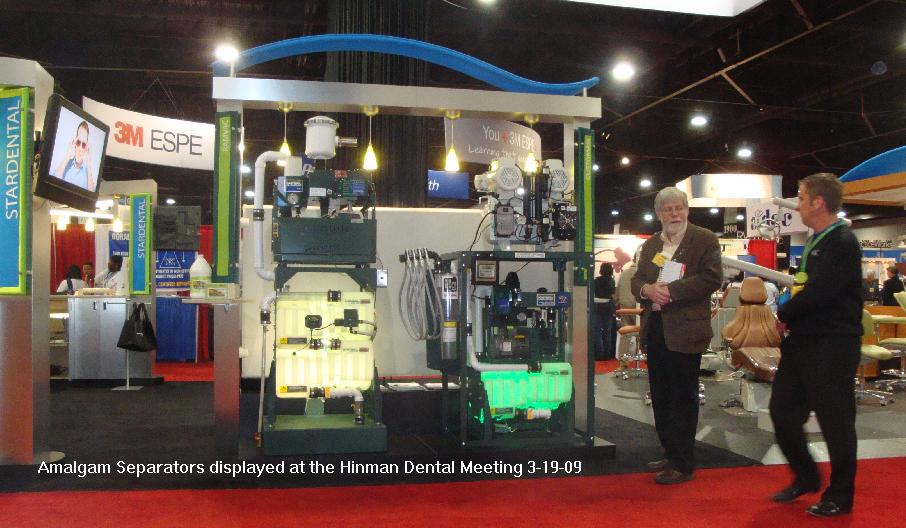
A M E R I C A N D E N T A L A S S O C I A T I O N
Central
District Dental
Society
Efforts towards
BMPs - Best Practice Management - for
Amalgam in Dental-Office Wastewater
Hinman Dental Meeting 2009

Also
Paticipated in a conference call on Wednesday, March
25, 2009, 4:30 p.m., Central Time, for one hour.
|
Overview
|
||
Amalgam separators are devices designed to remove amalgam waste particles from dental office wastewater. The placement and removal of dental amalgam restorations generates amalgam waste particles that can be suctioned into the dental unit vacuum line and discharged into the public sewer system. The effort to reduce amalgam waste discharge from the dental office is the result of increasing pressure facing local wastewater treatment plants to reduce the concentration of mercury in effluent from their plants and the concentration of mercury in sludge. The ADA's Best Management Practices for amalgam waste include the use of amalgam separators. Although there is no national regulation requiring the installation of amalgam separators in U.S. dental offices, state and local requirements exist in some areas. - (information from ADA) |
||
| (Free) Amalgam Recyclers: None |
|
||
| Paul Kenworthy says
Vermont madated separaters as of this past January. There
was some grumbling, but everything seems to be working ok
now. Vermont State Dental Society http://www.vsds.org/ 1-800-640-5099 |
||
| |
||
|
Subject: RE: BMP for amalgam http://www.p2pays.org/ref/18/17432.pdf The Environmentally Responsible
Dental Office:
Dr. Robert Shaw, DDS: said that the use of
mercury amalgam is not controversial: http://www.toxicteeth.org/rebuttal.cfm |
||
Clear Tubes to collect Amalgam here: http://www.theamalgamcollector.com/?refresh=1 |
Mercury-Based Chlorine Plants Rival Coal-Burning Power Plants as Mercury Pollutershttp://oceana.org/index.php?id=339As the extent of mercury contamination in our environment, our bodies and our food comes to light, concern over mercury pollution is increasing. While most media and public attention has focused on coal-burning power plants, most people remain unaware that a small subset of the chlorine industry makes a major - and completely preventable - contribution to the global mercury crisis. |
|||
|
|
Additional Information on Mercuryhttp://www.oceana.org/north-america/what-we-do/stop-seafood-contamination/reports-resources/Fish Consumption Advice
Human Health Studies
http://www.oceana.org/fileadmin/oceana/uploads/mercury/poisonplants_1/Georgia_Mercury_Report.pdf has graphic of top 10 mercury company polluters - top is GaPower- Plant Scherer Mercury Contamination This Olin plant has leaked and released enough mercury into its surrounding environment to qualify as a RCRA Corrective Action Site.201Throughout 2003 and 2004, the plant failed to monitor waste releases to groundwater as required by its RCRA permit.202 Additionally, LCP, a division of Hanlin Group (Allied) operated a mercury-cell plant in Brunswick, GA from 1957 to 1994. The Brunswick site, the majority of which is tidal marsh, is a Superfund site.203 EPA estimates that more than 380,000 pounds (over 170,000 kg) of mercury were “lost” in the area during the period of operation of the plant.204 Mercury and polychlorinated biphenyls (PCBs) have been detected in aquatic life at levels sufficient to produce a ban on commercial fishing in these areas and a seafood consumption advisory for part of the river and all of the creek.205 2004 Mercury-Related Fish Advisories206 Georgia issued 178 fish consumption advisories – relating to 40 different rivers and 34 lakes and ponds. Near the Olin plant, in the Savannah River Basin, there were 24 advisories, affecting five rivers and seven lakes and ponds. In the Purvis Creek area near the Brunswick Superfund site, Georgia currently recommends eating no more than one meal per week of red drum, and one meal per month of blue crab, spotted seatrout, Southern kingfish (whiting), and sheepshead, due to mercury contamination.207These recommendations are based on data collected in 2002, three years after EPA excavated the vast majority of on-site soil and waste piles.208The previous year’s (2003) consumption guidelines based on ecological data collected in 1995 were more restrictive (for example, it was not safe to eat red drum), which indicates that mercury levels may have decreased following the cleanup.209 The state also has issued mercury warnings for the whole estuary (St. Simon’s Estuary). Georgia, Florida and South Carolina jointly issued an advisory recommending that no one eat king mackerel more than 39 inches long (15 –17 lbs.), and that pregnant women, nursing mothers and children restrict their consumption of smaller fish (33 – 39 inches) to one meal per month. The states also recommended that other adults limit their consumption of smaller King Mackerel (33 – 39 inches) to one meal per week. |
||
|
From: "neill herring" <neillherring@earthlink.net>
Subject: Fw: 6pm radio show on GPB--message from Savannah
Riverkeeper
8-14-08 @ 5:30pm
Good
afternoon all,
I wanted to encourage you to listen to the Georgia Gazette Radio Show
tomorrow broadcasting at 6:35 am, 8:35am, and 6pm on Georgia Public
Radio. The story Friday is about our battle against Olin Corporation on
the
Sorry for the soap box, but I do hope all of you will have a chance to
listen to the story and support the legislation that would end this
madness once and for all. If you would like to learn more about
the issue www.oceana.org is the
best place to fill you in. Well that, and I am never short of
information and love to talk peoples ears off about the subject. Hope
all is well, TB Tonya
Bonitatibus (706)
755-4839
|
|||